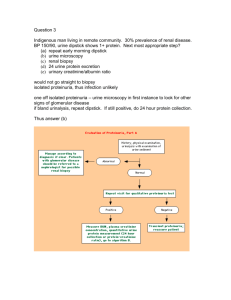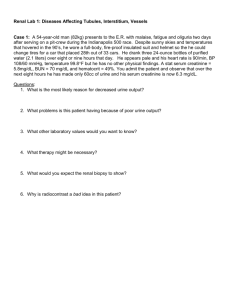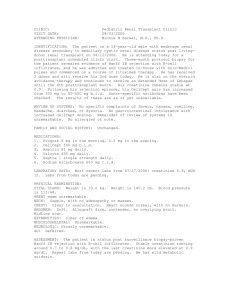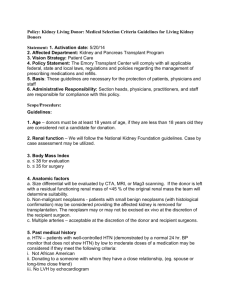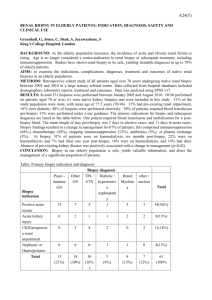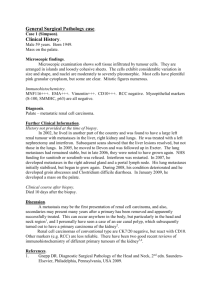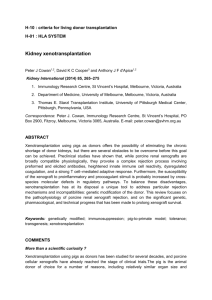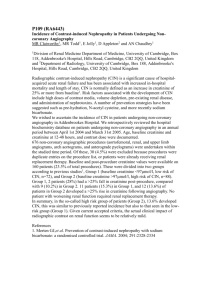Cases and Questions for Group Session #1
advertisement
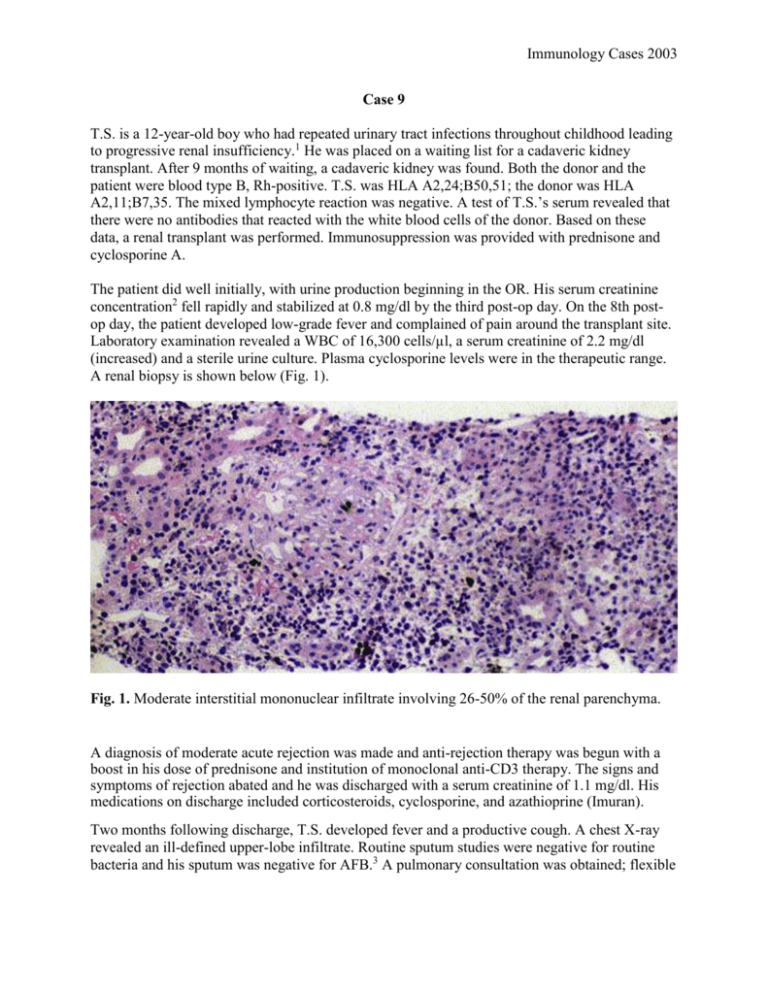
Immunology Cases 2003 Case 9 T.S. is a 12-year-old boy who had repeated urinary tract infections throughout childhood leading to progressive renal insufficiency.1 He was placed on a waiting list for a cadaveric kidney transplant. After 9 months of waiting, a cadaveric kidney was found. Both the donor and the patient were blood type B, Rh-positive. T.S. was HLA A2,24;B50,51; the donor was HLA A2,11;B7,35. The mixed lymphocyte reaction was negative. A test of T.S.’s serum revealed that there were no antibodies that reacted with the white blood cells of the donor. Based on these data, a renal transplant was performed. Immunosuppression was provided with prednisone and cyclosporine A. The patient did well initially, with urine production beginning in the OR. His serum creatinine concentration2 fell rapidly and stabilized at 0.8 mg/dl by the third post-op day. On the 8th postop day, the patient developed low-grade fever and complained of pain around the transplant site. Laboratory examination revealed a WBC of 16,300 cells/µl, a serum creatinine of 2.2 mg/dl (increased) and a sterile urine culture. Plasma cyclosporine levels were in the therapeutic range. A renal biopsy is shown below (Fig. 1). Fig. 1. Moderate interstitial mononuclear infiltrate involving 26-50% of the renal parenchyma. A diagnosis of moderate acute rejection was made and anti-rejection therapy was begun with a boost in his dose of prednisone and institution of monoclonal anti-CD3 therapy. The signs and symptoms of rejection abated and he was discharged with a serum creatinine of 1.1 mg/dl. His medications on discharge included corticosteroids, cyclosporine, and azathioprine (Imuran). Two months following discharge, T.S. developed fever and a productive cough. A chest X-ray revealed an ill-defined upper-lobe infiltrate. Routine sputum studies were negative for routine bacteria and his sputum was negative for AFB.3 A pulmonary consultation was obtained; flexible Immunology Cases 2003 Case 9, cont’d fiberoptic bronchoscopy4 revealed purulent secretions from the right upper lobe bronchus. BAL5 samples and transbronchial biopsies were obtained (Fig. 2). Fig. 2. This micrograph depicts a fungus that exhibits long uniform and septate hyphae. The hyphae have parallel contours and branch at 45. This appearance is consistent with Aspergillus. Cultures from BAL specimens were negative for Gram-negative6 and Gram-positive bacteria and a silver stain was negative for Pneumocystis carinii.7 However, multiple cultures grew Aspergillus fumigatus. A diagnosis of invasive Aspergillosis was made based on the transbronchial biopsy and culture results and the patient received anti-fungal therapy with Amphotericin B. He recovered uneventfully. His mainenance immunosuppression subsequently consisted of low doses of corticosteroids, cyclosporine, and mycophenolate mofetil. Fig. 3. Renal biopsy obtained three years post-transplant. (Left) Severe fibrointimal hyperplasia leading to obliterative arteriopathy. (Right) Chronic transplant glomerulopathy with lymphocytic infiltrate. Both findings are consistent with chronic rejection. Three year following transplantation, the patient’s creatinine began to rise and he developed gradually increasing proteinuria. A renal biopsy was obtained (Fig. 3). A diagnosis of chronic rejection was made. The patient underwent allograft nephrectomy and was maintained on hemodialysis. Immunology Cases 2003 Case 9, cont’d 1 Renal failure 2 A metabolite of creatine that is used as an index of renal function. Patients with renal failure have serum creatinine concentrations over 1.1 mg/dl. 3 Acid-fast bacilli refers to the appearance of Mycobacteria and a few other species, such as Nocardia, following a histochemical stain that appears red under light microscopy. 4 A technique used by Pulmonologists to visualize the upper and the large and medium lower airways. It involves the introduction, typically intranasally, of a flexible tube containing fiberoptic cables that illuminate the airways. Samples can be taken by instillation of fluid and witdrawal, or by biopsy forceps. 5 Broncholveolar lavage involves sampling of material from the bronchi and alveoli following instillation and withdrawal of about 60 cc of saline into a bronchus. 6 A histochemical stain that distinguishes broad categories of bacteria. Gram-negative bacteria are often derived from the gut. 7 A fungal pneumonia that is seen in AIDS and other conditions typified by decreased T-cell function. Questions for Case 9 (1) What is a haplotype match? What genetic mechanism would cause an individual not to be a haplotype match with his/her parents? (2) What is the MLR and what is the significance of a negative MLR? What molecular differences are detected by an MLR assay? (3) What is the mechanism of action of each of the following: (a) corticosteroids; (b) azathioprine; (c) cyclosporine; (d) mycophenolate mofetil (e) anti-CD3 antibodies (4) What type of rejection would be anticipated if the patient received: (a) an ABO mismatched kidney? (b) a kidney from a donor to which the patient had a positive MLR? (c) a kidney from a donor to which the patient had pre-formed anti-leukocyte antibodies? (5) When the patient was undergoing acute rejection, the graft became swollen and tender. What immunological event mediated this? (6) Why did the patient develop an invasive infection with Aspergillus? (7) The status of the donor’s HLA class II was unknown. Is this a factor in the prolongation of graft survival? Could the patient’s underlying disease affect graft survival? What is the current 5 year survival of cadaveric kidney allografts?
